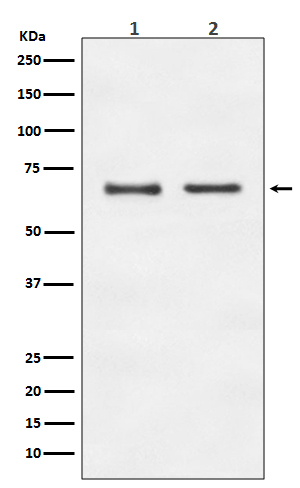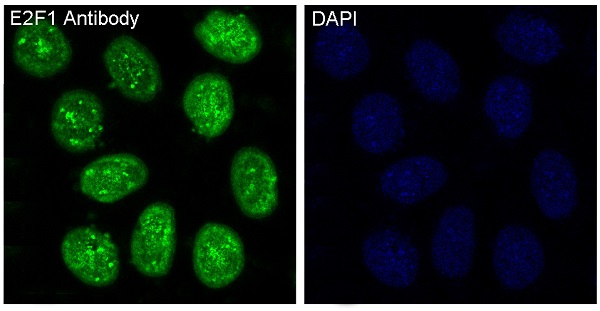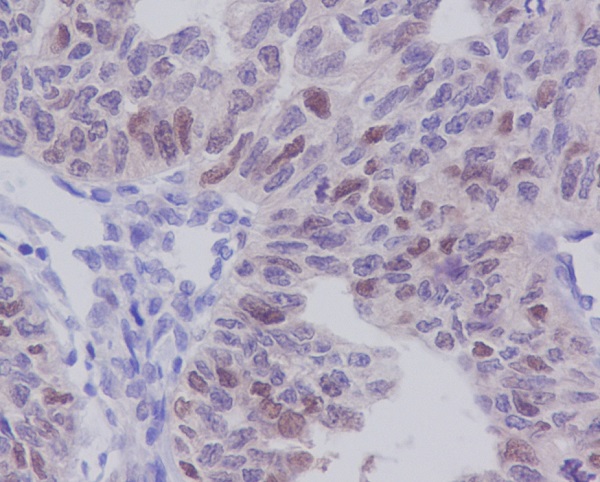


| WB | 1/500-1/1000 | Human,Mouse,Rat |
| IF | 1/20 | Human,Mouse,Rat |
| IHC | 1/50-1/100 | Human,Mouse,Rat |
| ICC | 1/50-1/200 | Human,Mouse,Rat |
| FCM | 1/50-1/100 | Human,Mouse,Rat |
| Elisa | 咨询技术 | Human,Mouse,Rat |
| Aliases | E2F1; RBBP3; Transcription factor E2F1; E2F-1; PBR3; Retinoblastoma-associated protein 1; RBAP-1; Retinoblastoma-binding protein 3; RBBP-3; pRB-binding protein E2F-1 |
| Entrez GeneID | 1869 |
| WB Predicted band size | Calculated MW: 47 kDa; Observed MW: 65 kDa |
| Host/Isotype | Rabbit IgG |
| Antibody Type | Primary antibody |
| Storage | Store at 4°C short term. Aliquot and store at -20°C long term. Avoid freeze/thaw cycles. |
| Species Reactivity | Human,Mouse,Rat |
| Immunogen | A synthesized peptide derived from human E2F1 |
| Formulation | Purified antibody in PBS with 0.05% sodium azide. |
+ +
以下是关于E2F1抗体的3篇参考文献及其摘要内容:
---
1. **文献名称**:*"E2F1-specific regulation of gene expression in vivo"*
**作者**:DeGregori, J. et al.
**摘要**:该研究通过免疫沉淀和染色质分析,利用E2F1抗体揭示了E2F1在体内调控的靶基因,发现其通过结合特定启动子区域激活细胞周期相关基因(如Cyclin E和Cdc2),为理解E2F1在细胞增殖中的作用提供了机制基础。
2. **文献名称**:*"Expression of E2F1 in human tumors: Roles in proliferation and apoptosis"*
**作者**:Wu, L. et al.
**摘要**:通过免疫组织化学(IHC)和Western blot分析多种癌症样本,研究发现E2F1在肿瘤中异常高表达,且与增殖标志物Ki-67正相关,但在某些病例中其促凋亡功能被抑制,提示E2F1在肿瘤中的双重作用依赖于细胞环境。
3. **文献名称**:*"DNA damage activates a transcriptional response to E2F1 in human cells"*
**作者**:Kent, L.N. & Lees-Miller, S.P.
**摘要**:该研究利用E2F1抗体进行染色质免疫共沉淀(ChIP)和蛋白定位分析,发现DNA损伤后E2F1被ATM磷酸化并激活特定修复相关基因,表明其参与调控DNA损伤应答,为癌症治疗中靶向E2F1提供了新思路。
---
以上文献均明确涉及E2F1抗体的实验应用(如Western blot、IHC、ChIP等),涵盖机制研究、疾病关联及功能探索,可作为相关研究的参考。
The E2F1 antibody is a crucial tool in molecular biology for studying the E2F1 transcription factor, a key regulator of cell cycle progression and apoptosis. E2F1 belongs to the E2F family of proteins, which control the transition from the G1 to S phase by regulating genes essential for DNA replication and cell division. E2F1 has dual roles: it promotes cell proliferation under normal conditions but can also induce apoptosis in response to DNA damage or stress, depending on cellular context. Dysregulation of E2F1 is implicated in cancer, where overexpression often correlates with uncontrolled proliferation, while loss of function may disrupt apoptotic pathways.
Researchers use E2F1 antibodies in techniques like Western blot (WB), immunohistochemistry (IHC), and chromatin immunoprecipitation (ChIP) to detect E2F1 expression, localization, and DNA-binding activity. These antibodies are critical for exploring E2F1’s interactions with tumor suppressors (e.g., retinoblastoma protein, pRB) or oncogenic pathways. Available as monoclonal or polyclonal variants, E2F1 antibodies are typically raised in hosts like rabbits or mice and validated for specificity across applications. Their utility extends to cancer research, particularly in assessing tumor progression, therapeutic responses, and mechanisms of drug resistance. Commercial antibodies often include validated data on cross-reactivity, epitope regions, and recommended dilutions, ensuring reproducibility in experimental models.
×